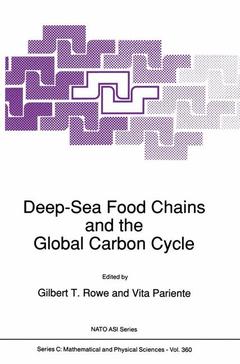Deep-Sea Food Chains and the Global Carbon Cycle, Softcover reprint of the original 1st ed. 1992 Nato Science Series C: Series, Vol. 360
Langue : Anglais
Coordonnateurs : Rowe G.T., Pariente Vita

Carbon dioxide and other `greenhouse' gases are increasing in the atmosphere due to the burning of fossil fuels, the destruction of rain forests, etc., leading to predictions of a gradual global warming which will perturb the global biosphere. An important process which counters this trend toward potential climate change is the removal of carbon dioxide from the surface ocean by photosynthesis. This process packages carbon in phytoplankton which enter the food chain or sink into the deep sea. Their ultimate fate is a `rain' of organic debris out of the surface-mixed layer of the ocean. On a global scale, the mechanisms and overall rate of this process are poorly known.
The authors of the 25 papers in this volume present their state-of-the-art approaches to quantifying the mechanisms by which the `rain' of biogenic debris nourishes deep ocean life.
Prominent deep sea ecologists, geochemists and modelers address relationships between data and models of carbon fluxes and food chains in the deep ocean. An attempt is made to estimate the fate of carbon in the deep sea on a global scale by summing up the utilization of organic matter among all the populations of the abyssal biosphere. Comparisons are made between these ecological approaches and estimates of geochemical fluxes based on sediment trapping, one-dimensional geochemical models and horizontal (physical) input from continental margins.
Planning interdisciplinary enterprises between geochemists and ecologists, including new field programs, are summarized in the final chapter. The summary includes a list of the important gaps in understanding which must be addressed before the role of the deep-sea biota in global-scale processes can be put in perspective.
The authors of the 25 papers in this volume present their state-of-the-art approaches to quantifying the mechanisms by which the `rain' of biogenic debris nourishes deep ocean life.
Prominent deep sea ecologists, geochemists and modelers address relationships between data and models of carbon fluxes and food chains in the deep ocean. An attempt is made to estimate the fate of carbon in the deep sea on a global scale by summing up the utilization of organic matter among all the populations of the abyssal biosphere. Comparisons are made between these ecological approaches and estimates of geochemical fluxes based on sediment trapping, one-dimensional geochemical models and horizontal (physical) input from continental margins.
Planning interdisciplinary enterprises between geochemists and ecologists, including new field programs, are summarized in the final chapter. The summary includes a list of the important gaps in understanding which must be addressed before the role of the deep-sea biota in global-scale processes can be put in perspective.
Bacterial Standing Stock and Consumption Of Organic Carbon in The Benthic Boundary Layer of The Abyssal North Atlantic.- Natural Bacterial Assemblages in Deep-Sea Sediments: Towards A Global View.- The Role of Deep-Sea Zooplankton in Carbon Cycles.- Abundance and Biomass of Metazoan Meiobenthos in The Deep Sea.- The Role Of Benthic Foraminifera in Deep-Sea Food Webs and Carbon Cycling.- Possible Roles For Xenophyophores in Deep-Sea Carbon Cycling.- Foraging of Scavenging Deep-Sea Lysianassoid Amphipods.- Deep-Sea Epibenthic Megafauna of The Northeast Atlantic: Abundance And Biomass At Three Mid-Oceanic Locations Estimated From Photographic Transects.- South Aegean (Eastern Mediterranean) Continental Slope Benthos: Macroinfaunal-Environmental Relationships.- Production/Biomass Ratios, Size Frequencies and Biomass Spectra in Deep-Sea Demersal Fishes.- Organic Carbon Flux Through The Benthic Community in The Temperate Abyssal Northeast Atlantic.- Benthic Secondary Production in The Deep Sea.- Metabolic Potential of Deep-Sea Animals: Regional and Global Scales.- Adenosine Nucleotides as Indicators of Deep-Sea Benthic Metabolism.- Effects of Spatial and Temporal Scale on The Relationship of Surface Pigment Biomass to Community Structure in The Deep-Sea Benthos.- Benthic Food Web Flows in The Santa Monica Basin Estimated Using Inverse Methodology.- Predicting Community Dynamics From Food Web Structure.- The Spatial Distribution of Sea Floor Oxygen Consumption in The Atlantic and Pacific Oceans.- Using Monod Kinetics in Geochemical Models of Organic Carbon Mineralization in Deep Sea Surficial Sediments.- The Characterization of Organic Matter From Abyssal Sediments, Pore Waters and Sediment Traps.- Particle Export and Resuspension Fluxes in The Western North Atlantic.- Large Aggregate Flux and Fate at The Seafloor: Diagenesis During The Rebound Process.- Factors Controlling Bioturbation in Deep-Sea Sediments and Their Relation to Models of Carbon Diagenesis.- Adding Biology to One-Dimensional Models of Sediment-Carbon Degradation: The Multi-B Approach.
Date de parution : 10-2012
Ouvrage de 400 p.
15.5x23.5 cm
Disponible chez l'éditeur (délai d'approvisionnement : 15 jours).
Prix indicatif 52,74 €
Ajouter au panierThèmes de Deep-Sea Food Chains and the Global Carbon Cycle :
© 2024 LAVOISIER S.A.S.



